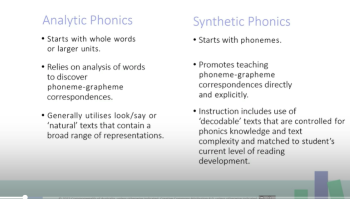Introduction to SSP - Module 4: features of a systematic synthetic phonics approach

Categories
Audience
Purpose
Topic
Details
Source
Literacy Hub
Copyright
© Commonwealth of Australia
Overview
In the final module in this series about systematic synthetic phonics (SSP), Jocelyn Seamer, an expert in systematic reading instruction, discusses the features of an SSP approach.
View the transcript. | View the slide outlines.
Who is this video for?
Foundation to Year 2 teachers; school leaders.
What will you learn?
The key components of a good systematic synthetic phonics program.
The importance of following a scope and sequence to guide reading and spelling instruction.
How to choose and use decodables.
How to monitor and assess student progress.
Presenter
Jocelyn Seamer is a teacher, tutor and school leader with extensive first-hand experience of evidence-informed practice in reading instruction. She leads educators to grow and develop school policy and practice to reflect the principles of the Science of Reading and Learning. She is the author of Reading success in the early primary years (2022); and produces 'The structured literacy podcast'.
Related content
Phonics professional learning: implementing a systematic synthetic phonics approach
The Literacy Hub provides free, online professional learning to support schools through each step of building a systematic synthetic phonics (SSP) approach for reading and spelling. It includes online reading, free downloadable resources and webinars.
Getting started with a phonics progression
This professional learning topic covers the elements of a high-quality, evidence-aligned phonics progression for reading and spelling; and the component skills required for phonological and phonemic awareness development.
Back to search results